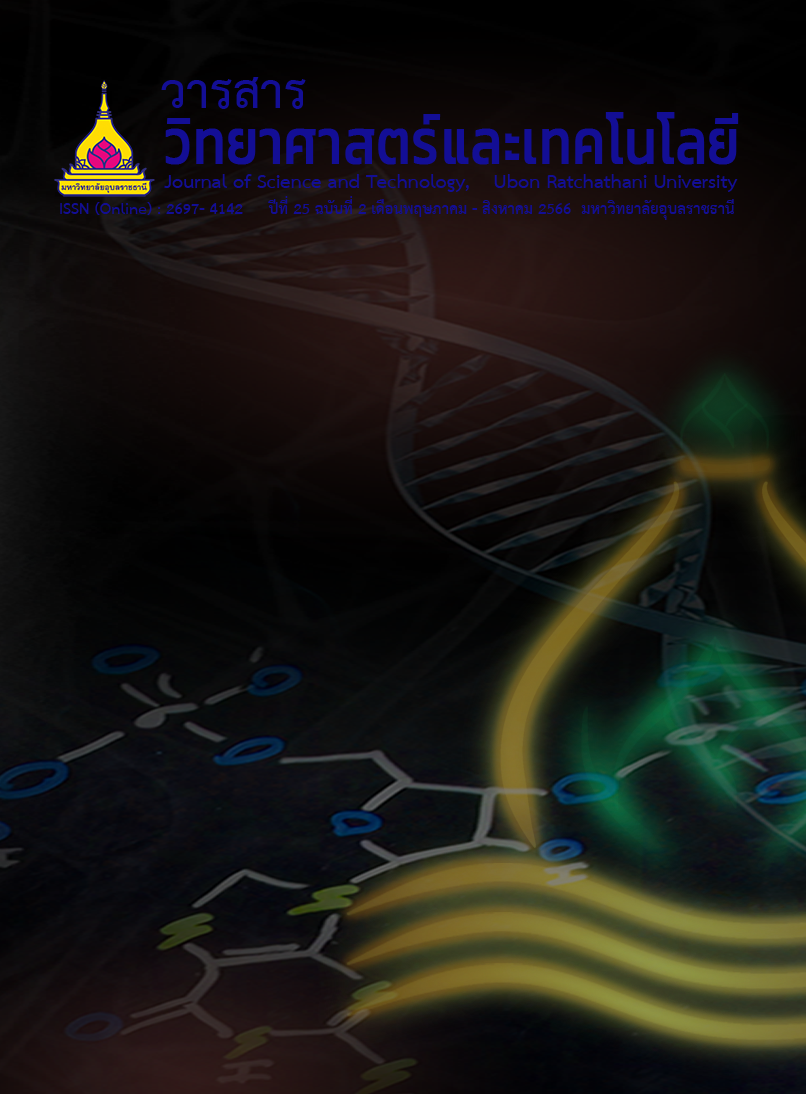อิทธิพลของปัจจัยทางนิเวศวิทยาต่อความหลากหลายของแมงมุมในนาข้าวอินทรีย์
Main Article Content
บทคัดย่อ
นาข้าวเป็นระบบนิเวศที่มีการเปลี่ยนแปลงโครงสร้างภายในตลอดเวลาตั้งแต่ก่อนเริ่มปลูกข้าวจนถึงหลังการเก็บเกี่ยว ทำให้สิ่งมีชีวิตหลากหลายชนิดเข้ามาใช้ประโยชน์ในทุกระยะของการเปลี่ยนแปลงของนาข้าว ส่งผลให้มีความหลากหลายของสิ่งมีชีวิตโดยเฉพาะกลุ่มแมงมุมที่เข้ามาอาศัยในนาข้าว ปัจจุบันความเข้าใจเกี่ยวกับนิเวศวิทยาของแมงมุมในนาข้าวยังมีไม่มาก ดังนั้นงานวิจัยนี้จึงมีวัตถุประสงค์เพื่อศึกษาอิทธิพลของปัจจัยทางนิเวศวิทยาบางประการต่อความหลากหลายของแมงมุมในนาข้าวอินทรีย์ โดยสำรวจแมงมุมในนาข้าวอินทรีย์แห่งหนึ่งในจังหวัดนครปฐมในช่วงเดือนสิงหาคม 2557 ถึงเดือนมีนาคม 2558 ด้วยวิธีการสำรวจ 4 วิธี ได้แก่ การใช้กับดักหลุมพราง การใช้สวิงโฉบ การสำรวจด้วยตาเปล่า และการใช้แปลงสุ่มตัวอย่าง ปัจจัยทางนิเวศวิทยาที่นำมาพิจารณา ได้แก่ ความสูงของต้นข้าว จำนวนใบข้าวต่อกอ ความหนาแน่นของต้นข้าว ความสูงของระดับน้ำในแปลงข้าว อุณหภูมิอากาศ และความชื้นสัมพัทธ์ จากการศึกษาพบแมงมุมในนาข้าวอินทรีย์ 2,158 ตัว จำแนกได้ 11 วงศ์ 30 สกุล และ 47 ชนิด จากการวิเคราะห์ความสัมพันธ์ พบว่าความสูงของต้นข้าว ความหนาแน่นของต้นข้าว มีความสัมพันธ์เชิงบวกกับจำนวนแมงมุม และดัชนีความหลากชนิดของแมงมุมอย่างมีนัยสำคัญทางสถิติ นอกจากนี้ยังพบว่าจำนวนใบข้าวต่อกอก็มีความสัมพันธ์เชิงบวกกับดัชนีความหลากชนิดของแมงมุมอย่างมีนัยสำคัญทางสถิติด้วย อย่างไรก็ตาม จากการวิเคราะห์ความสัมพันธ์พบว่าแมงมุมที่อยู่ในกลุ่ม functional groups ต่าง ๆ มีความสัมพันธ์กับปัจจัยทางนิเวศวิทยาที่แตกต่างกัน ข้อมูลที่ได้จากการศึกษานี้ชี้ให้เห็นถึงความสำคัญของนาข้าวอินทรีย์ต่อความหลากหลายของแมงมุม และอาจมีประโยชน์ต่อการอนุรักษ์ความหลากหลายของแมงมุมในประเทศไทย
Article Details

อนุญาตภายใต้เงื่อนไข Creative Commons Attribution-NonCommercial-NoDerivatives 4.0 International License.
บทความที่ได้รับการตีพิมพ์เป็นลิขสิทธิ์ของ วารสารวิทยาศาสตร์และเทคโนโลยี มหาวิทยาลัยอุบลราชธานี
ข้อความที่ปรากฏในบทความแต่ละเรื่องในวารสารวิชาการเล่มนี้เป็นความคิดเห็นส่วนตัวของผู้เขียนแต่ละท่านไม่เกี่ยวข้องกับมหาวิทยาลัยอุบลราชธานี และคณาจารย์ท่านอื่นๆในมหาวิทยาลัยฯ แต่อย่างใด ความรับผิดชอบองค์ประกอบทั้งหมดของบทความแต่ละเรื่องเป็นของผู้เขียนแต่ละท่าน หากมีความผิดพลาดใดๆ ผู้เขียนแต่ละท่านจะรับผิดชอบบทความของตนเองแต่ผู้เดียว
เอกสารอ้างอิง
Ramadhani, F. and et al. 2020. Automatic mapping of rice growth stages using the integration of SENTINEL-2, MOD13Q1, and SENTINEL-1. Remote Sensing. 12: 3613.
Fakkam, W. and et al. 2018. Effect of ecological engineering system on diversity of insects and spiders in rice paddy field. Journal of Agriculture. 34(2): 235-243. (in Thai)
Heong, K.L. 2009. Are planthopper problems caused by a breakdown in ecosystem services? In: Heong, K.L. and Hardy, B. (eds.) Planthoppers: New Threats to the Sustainability of Intensive Rice Production Systems in Asia. Los Banos: International Rice Research Institute.
Begum, M. and et al. 2004. Flower color affects tri-trophic-level biocontrol interactions. Biological Control. 30: 584-590.
Cotes, B. and et al. 2018. Spider communities and biological control in native habitats surrounding greenhouses. Insects. 9(1): 33.
Riechert, S.E. and Lockley, T.C. 2003. Spiders as biological control agents. Annual Review of Entomology. 29(1): 299-320
Michalko, R., Pekar, S. and Entling, M.H. 2019. An updated perspective on spiders as generalist predators in biological control. Oecologia. 189: 21-36.
Wise, D.H. 1993. Spiders in Ecological Web. Cambridge: Cambridge University Press.
Rattanapun, W. 2012. Diversity and population dynamics of pests and predators in irrigated rice fields with treated and untreated pesticide. Communications in Agricultural and Applied Biological Sciences. 77(4): 601-609.
Barrion, A.T. and Litsinger, J.A. 1996. Riceland Spiders of South and Southeast Asia. 1st edition. Oxford: Oxford University Press.
Jocque, R. and Dippenaar-Schoeman, A.S. 2006. Spider Families of the World. 2nd edition. Flemish Brabant: Royal Museum for Central Africa.
Murphy, F. and Murphy, J. 2000. An Introduction to the Spiders of South-East Asia. Kuala Lumpur: Malaysian Nature Society.
Tsutsui, M.H. and et al. 2016. Spatio-temporal dynamics of generalist predators (Tetragnatha spider) in environmentally friendly paddy fields. Applied Entomology and Zoology. 51(4): 631-640.
Anis Joseph, R. and Premila, K.S. 2016. A study on the richness of spider fauna in rice ecosystem. Journal of Entomology and Zoology Studies. 4(2): 425430.
Saha, S., Bhadra, A. and Raychaudhuri, D. 2020. Diversity spectrum of spider fauna in backyard rice agroecosystem, Narendrapur, West Bengal, India. World Scientific News. 147: 61-75.
Cardoso, P. and et al. 2011. Global patterns of guild composition and functional diversity of spiders. PLoS One. 6(6): e21710.
Rypstra, A.L. and et al. 1999. Architectural features of agricultural habitats and their impact on the spider inhabitants. Journal of Arachnology. 27: 371-377.
Yang, K.J., Im, M.S. and Kim, S.T. 1998. Studies on the ecology of spiders as natural enemy for rice insect pest at rice paddy field in Keumsan area, Chungcheongnam-do. The Research Bulletin of Agricultural Life Resource Science Institute Joongbu University. 6: 46-56.
Kiritani, K. and et al. 1972. Quantitative evaluation of predation by spiders on the green rice leafhopper, Nephotettix cincticeps Uhler, by a sight-count method. Researches on Population Ecology. 13: 187-200.
Uetz, G.W., Johnson, A.D. and Schemske, D.W. 1978. Web placement, web structure and prey capture in orb-weaving spiders. Bulletin of the British Arachnological Society. 4: 141-148.
Foelix, R.F. 2011. Biology of Spiders. 3rd edition. Oxford: Oxford University Press.
Colebourne, P.H. 1974. The influence of habitat structure on the distribution of Araneus diadematus Clerck. Journal of Animal Ecology. 43: 401-409.
Sorapongpaisal, W. and et al. 2011. Species diversity of rice insect pests and natural enemies in organic rice paddy field. Journal of Agriculture. 27(1): 39-48. (in Thai)
Srising, H. 2008. Factors Relating to the Growing of Organic Rice as Accepted by Farmers under the Organic Farming Program in Bangprama District, Suphanburi Province. M.Sc. Thesis, Silpakorn University. (in Thai)


